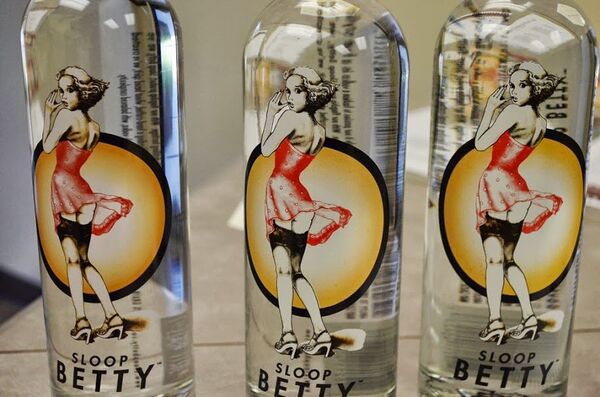STEVENSVILLE, Maryland, July 3 (by Karin Zeitvogel for RIA Novosti) – In a nondescript industrial complex on an island in the Chesapeake Bay, two American brothers are taking a leaf out of Russian master distillers’ books, and making organic vodka that they call Sloop Betty.
“By default, the vodka cookbook is originally Russian. We pay homage to Russia when we make our vodka,” Jon Cook, who set up Blackwater Distilling in 2008 with his brother, Chris, told RIA Novosti during a tour of their production facility.

Jon Cook (L) and brother Chris inside Blackwater Distillery, where they have made vodka since 2011. (K. Zeitvogel)
The brothers began pumping Sloop Betty vodka into clear glass bottles with an image of a World War II pin-up girl on them in April 2011, after a lengthy licensing and product development process that included multiple taste tests.
“We tried a little bit of everything, and what we went with in the end was what tasted the best – organic wheat,” Jon Cook said.
Many Russian vodkas are made from wheat, but the clear spirit can be made from anything, his brother Chris said.
Small distilleries, like Blackwater – which is named after a nearby natural reserve – typically use crops that are easy to get in their area.
“There’s a guy in Vermont who uses milk. Two brothers in Maine make their vodka from potatoes because it’s the surplus crop in the state. You can get vodka made from maple syrup. In fact, you can make vodka from anything,” Chris Cook said.
Vodka is the preferred spirit of craft distillers because it does not have to be aged and, if it’s embraced by the drinking public, brings cash flow in to a new business almost immediately.
Vodka has gone from having a tiny share of the US spirits market in the Prohibition era, which lasted through the 1920s into the beginning of the 1930s, to become the favorite spirit of Americans, who last year bought more than 65 million cases of vodka, each containing 12 bottles, generating $5.5 billion in revenue for distillers, according to the Distilled Spirits Council of the United States (DSCUS).
Last year alone, 171 new vodka products made their debut on the US market, the majority of them flavored vodkas, DSCUS said.
On that crowded shelf, the Cook brothers had to make their vodka stand out. So they added 20 percent sugar cane to the wheat base, resulting in a smooth vodka that can be drunk neat at room temperature.
The bottle itself is also an eye-catcher, featuring a World War II pin-up girl. Sloop Betty bottles are made from clear glass to allow consumers, and the Cook brothers, to more easily check the vodka for impurities.
The brothers also decided from the start to tie their vodka either to their family or to the state of Maryland, where they are the first distillery in nearly four decades to be licensed.
The pin-up girl is a tribute to their grandfather, who flew fighter planes in Europe during World War II. Sloop Betty is the name of a ship that sailed the Chesapeake Bay in the 17th and 18th centuries and at one point was commandeered by Blackbeard the pirate.
Even the bottle caps on Sloop Betty vodka are a nod to Maryland history: the font used on them is adapted from the handwriting of state officials who signed the US Declaration of Independence.

The writing on Sloop Betty bottle caps is adapted from Maryland officials' signatures on the US Declaration of Independence. (K. Zeitvogel)
“We knew we would have to measure up to a very high standard set by Russian vodka, and we also wanted to put our own mark on our product. Sugar cane is a real differentiator inside the bottle, and the links to family or state history set us apart on the outside of the bottle,” Chris Cook said.
Last year, the brothers sold almost 8,000 bottles of Sloop Betty. This year, they’ve already sold that amount and, with their new flavored vodka -- made with raw, organic honey from local beekeeper Kara Brook -- set to hit liquor store shelves this summer, they expect to sell more than double that amount by year’s end.

Sloop Betty honey vodka is made with raw organic honey from local beekeeper Kara Brook's hives. (K. Zeitvogel)
Sloop Betty almost got a Russian name and a different label. The Cook brothers toyed with naming their vodka after a 19th century Russian sailor, identified only as N. Demidoff, who was shot dead in the Maryland state capital, Annapolis, while he was on shore leave in February 1864.
“Supposedly, after a local saloon refused him a drink, Demidoff started a barroom brawl and someone shot him during the melee,” the National Park Service says on its website.
Demidoff lies buried in the Civil War era Annapolis National Cemetery, alongside hundreds of soldiers who fought for the Union, or northern states.
The Cook brothers decided to bury his name as an option for their vodka because “even though his case was unique in state history and it had that link to Russia, which would go well with vodka, it wasn’t a very positive chapter in relations between the US and Russia,” Chris Cook said.
“So we stepped back and decided that, as intriguing as the story was, we should go in a different direction.”

